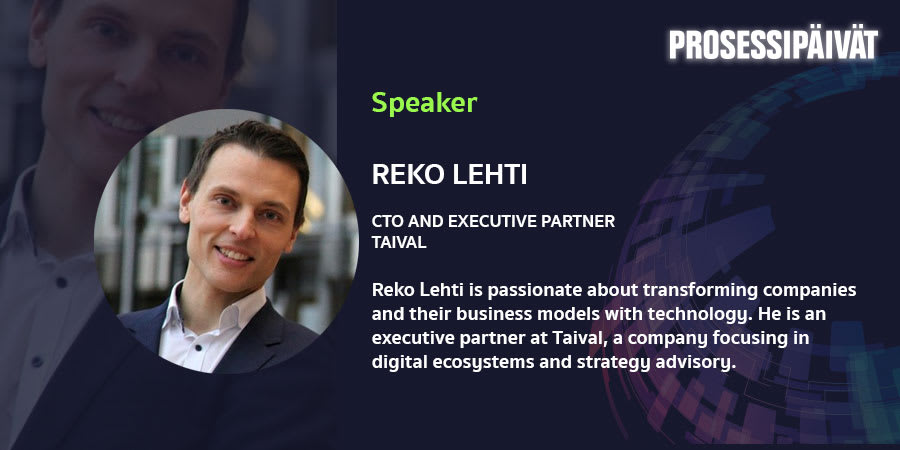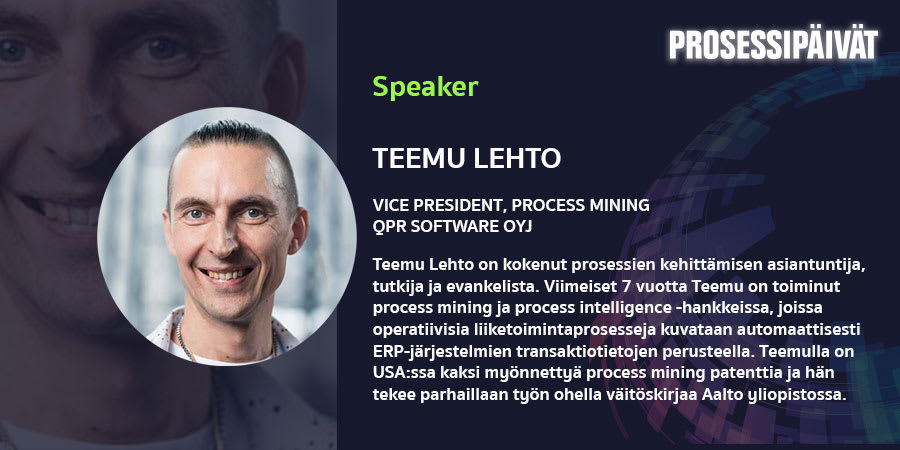Prosessipäivät on kuudessa vuodessa kasvanut Suomen palvelu- ja prosessijohtamisen kärkitapahtumaksi. Tapahtumassa kuullaan jälleen runsasta joukkoa asiantuntijoita, joita Oppian Blogilla on ilo esitellä!
Reko Lehti, Taival
17.5.2018 / AI / 10:55 – 11:30
Artificial intelligence, being today at the top of the hype curve, is touted as the harbinger of doom for traditional industries and the modern civilization. With its claimed ability to destroy whole professions, most notable of which are doctors and lawyers, the political and industry decision makers are understandably worried about its impact. How should a strategist approach this phenomenon? Pragmatically and systematically, as any change in the company operating environment.
Despite the complex technological concepts behind many of the more ground breaking features of AI , the capabilities it provides can easily be broken down to a skill list (as with the brilliant HBR article by Andrew Ng[1]), which can then be used as a reference when considering the impact it has to a function in the company.
Timeboxing the AI: Now and tomorrow
The problem with today’s discussion is that even the more informed leaders (case in point: Elon Musk/Mark Zuckerberg debate[2]) mix up the capabilities that are available now as opposed to something that might be available in the future (This was partially covered in an earlier blog post[3]). This is the real problem that should keep the strategists awake at night. The three questions that they should asking themselves in creating the strategy:
- How do I use what’s available today to advance our capabilities?
- How do I prepare for the future capabilities of AI?
- What is my AI vision and roadmap going forward?
Developing the capabilities of today
As many AI scientists are telling us, the powers of AI are greatly exaggerated. While there is no doubt it will change many industries fundamentally and lead to a loss of jobs, it is a far cry from HAL 9000 in Cubrick’s Space Odyssey.
As noted previously, the AI constructs of today are able to provide a set of skills that computers were unable to do previously (e.g. understand natural language, recognize pictures). Understanding these capabilities and their limitations and applying them creatively and innovatively to today’s business problems is what will create value in the organization. Be prepared to provide a LOT of relevant data to train your AI – otherwise the benefits will not realize. One excellent way to start is by looking at the organization’s processes and teaching the AI to optimize them.[4]
Another understated fact of strategic AI utilization is ensuring sufficient change management. It is not easy for employees to accept that a program is going to take away their work and do it so much more efficiently. Ensuring a smooth transition to AI-enabled operations requires planning, small successes and displays of AI-employee cooperation. (More on AI change management in a future article).
From strategy perspective, it’s important to ensure you understand what the competition (and multinational companies) are doing in the AI space and start developing similar or complementary services to counteract the effects. Consider what data is available (or can be captured or bought) to start developing differentiated services. The first AI applications do not necessarily need to bring bottom line value; there is inherent value in learning the AI industry mechanics and teaching the organization to live with AI solutions.
Preparing for the artificially intelligent tomorrow
As we are discussing strategy, we should consider also the farther future, where AI will have more futuristic capabilities. With the extended time-scale, we need to also broaden the scope of effects to consider, for example changes in the business ecosystem (no more lawyers) or in the operational processes (self-driving cars). Although the fully sentient AI is still not realistic (despite many people considering that it is), the next best thing, unsupervised learning for AI is considered to be operational in 3-5 years.
Despite what the technology pace is, these are the things you need to look at from the strategy perspective:
- Data – how to ensure the company has enough data collected of the key business processes to train and utilize an AI?
- Skills – where does the company get the skills to utilize the AI? What areas should the company focus on for internal skills and what needs to be bought from outside?
- Change management and vision – How do I transition the organization to an AI enabled company? How do I communicate the vision without causing change resistance?
When considering the future, one should not forget the other changes digitalization is creating: Data can be bought from other companies or new creative business models can be developed to offset the loss of old business. One thing is certain, however: no industry will be safe from the change.
Welcome to Process Days 2018 in Helsinki Finland to hear more: www.prosessipaivat.fi

[1] https://hbr.org/2016/11/what-artificial-intelligence-can-and-cant-do-right-now
[2] https://phys.org/news/2017-07-musk-zuckerberg-duel-artificial-intelligence.html
[3] http://taival.com/2017/05/31/dont-buy-artificial-intelligence-doesnt-exist-yet/
[4] http://taival.com/2017/06/16/three-steps-to-ai-powered-enterprise/
Blogi on julkaistu alunperin Taival kotisivuilla.


